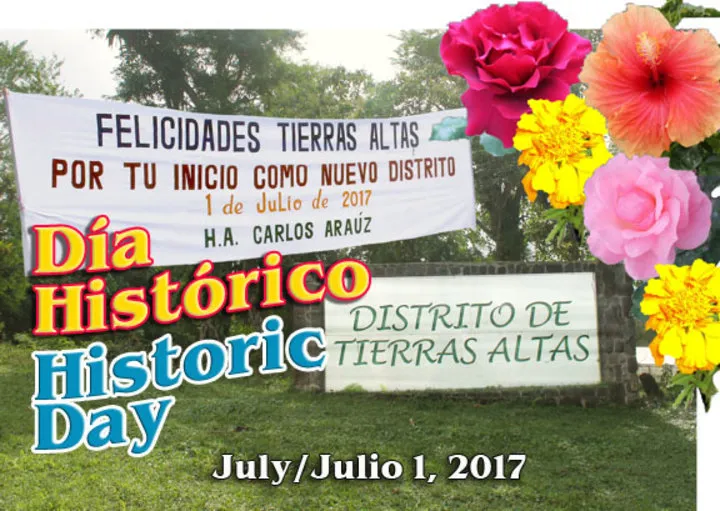Volcan becomes a district.

October 1502, a distant date when Cristopher Columbus, in his fourth voyage, arrived at Laguna de Chiriqui Grande (Chiriqui Grande’s Lagoon) and the indigenous habitants informed him about beautiful lands and another sea, just nine days of travel away; the days when Agustin Codazzi from the Engineering Team of the Great Colombia Army mapped Chiriqui, which were not only corroborated but corrected by the German Moritz Wagner.
We were part of the Veragua Dukedom, the Alanje Canton and, as part of the Bugaba District, we were born as the Baru Corregimiento by means of the municipal agreement N° 5 of November 30, 1924 with three departments: Nuevo Mundo, Tizingal, and Los Angeles, with limits to the north with the Bocas del Toro province; to the south, a straight line from east to west that cuts through Macho de Monte; to the east, with the Boquete and Boqueron districts, and to the West, the Republic of Costa Rica.
500 hectares of land were expropriated in “Los Potreros de Volcan” by the law N° 121 of 1928 to create a national forest surrounding the lagoons (200 hectares) and the east population (300 hectares). This law became officially active on 1957 when the distribution of lands began, Agustin Rivera De Sedas acting as the surveyor. Cerro Punta, then, segregated from our territory on November 11, 1953 by the Municipal Accord N° 33 and, in 1971, a large part of what comprises the Renacimiento District currently. Our region was recognized as Hato Volcan until Accord N° 1 of January 8, 1975 changed its name to Volcan.

The original movement, which began on October 1948, due to attempts by the Villegas family to relocate the inhabitants of Hato de Volcan and Nueva California, unfolded decades worth of resistance, fights, and efforts. It was on December 11, 1980, that the formal idea for the creation of the Tierras Altas (Highland) District saw the light of day through the creation of the Movement Pro Volcan Highland District.
The board was led by Faustino Fonseca Samudio (president), Jose Manuel Famanía (vice-president), Maria “Tita” Gonzalez (secretary), Braulia Lopez (treasurer), Norberto Pinedo Aguirre (spokesperson), Ruben Rodriguez (counselor), and Manuel Antonio Lopez Flores (counselor). Through a petition made by means of general Ruben Dario Paredes, it progressed to the President of the Republic, who developed the “Study about the Creation of the Highlands District” 1982-1983 through the Department of Local Governments of the Ministry of Government and Justice. This document reflected the socio-economic situation of the region.
Conversation and the community’s participation initiated towards solving many of the numerous issues afflicting them, for which they had no answers due to the centralization of the National and Municipal Government. These efforts were spoiled in 1984 by the opposition, mainly, by the Corregimiento Representative of the time.
With democracy at hand -in June 1990- a law project was presented at the National Assembly which was then moved to a commission in charge of studying it and which declared it did not possess all the necessary socio-economic requirements. Afterwards, a study by sample conducted by DIGEDECOM resulted in a positive result. Consequently, the commission of Constitutional Affairs presented the project which made it up to second debate.
On October 1994, legislator Denis Arce Morales, once more, presented the Law Project Draft through which the Highlands District would be created, only to suffer the same fate as its predecessors.

On February 2012 the riots in Volcan; the effects on the farmers of Brazos de Gariche and the surrounding areas gave origin to a brand new committee which would later be known as the Foundation pro Development of the Chiriqui Highlands.
The political solution presented by Deputy Rony Arauz to create a new district finally found fertile land, preventing backtrack on the proposal. The Law Draft 024, once approved brought upon the Law Project 525 which in turn became the Law 55 of September 13, 2013, creating the Highlands District. Last May 9, Law 22 of 2017 allowed the validity of Law 55 of July 1, 2017.
Highlands will be comprised of the corregimientos: Cuesta de Piedra, Volcan, Nueva California, Paso Ancho and Cerro Punta.
We celebrate this immense step, aware of the challenges, great and complex, that we face from now on.
The challenge of performing to the standards significant of this transition, between what has been and what we will become. In the best of the philosophical traditions: knowing what we are, where we are going, and how we will achieve it.
It is a Political challenge, uppercase –as it is-, because it must lie within a democratic district administration with no apex of politics. It is the challenge of working together, alongside, in the same direction, as solid partners, with the characteristic honesty that has always been a trademark for us. It must be the benefit of its inhabitants and visitors,of this fertile lands that nurture the country.
“There is a past that has left forevermore, but there is a future that is still ours”